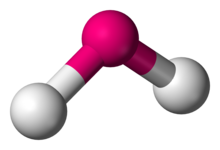Bent molecular geometry
| Bent molecular geometry | |
|---|---|
 | |
| Examples | H2O, SO2 |
| Point group | C2v |
| Coordination number | 2 |
| Bond angle(s) | 90°<θ<120° |
| μ (Polarity) | >0 |

In chemistry, molecules with a non-collinear arrangement of two adjacent bonds have bent molecular geometry, also known as angular or V-shaped. Certain atoms, such as oxygen, will almost always set their two (or more) covalent bonds in non-collinear directions due to their electron configuration. Water (H2O) is an example of a bent molecule, as well as its analogues. The bond angle between the two hydrogen atoms is approximately 104.45°.[1] Nonlinear geometry is commonly observed for other triatomic molecules and ions containing only main group elements, prominent examples being nitrogen dioxide (NO2), sulfur dichloride (SCl2), and methylene (CH2).
This geometry is almost always consistent with
Other cases also experience orbital hybridisation, but in different degrees. AX2E1 molecules, such as SnCl2, have only one lone pair and the central angle about 120° (the centre and two vertices of an equilateral triangle). They have three sp2 orbitals. There exist also sd-hybridised AX2 compounds of transition metals without lone pairs: they have the central angle about 90° and are also classified as bent.[citation needed] (See further discussion at VSEPR theory#Complexes with strong d-contribution).
See also
- AXE method
References
- ISBN 0-13-035471-6.
